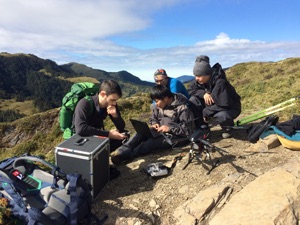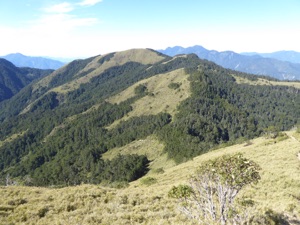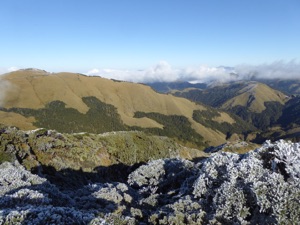Understanding the and predicting changing mountain forest distribution in Taiwan

Taiwan fir (Abies kawakamii) forms near monodominant forests up to the high elevation treeline in much of Taiwan’s Central Mountain Range. At the highest elevations, the A. kawakamii tree line shows high spatial variability, driven by climatic and habitat heterogeneity and biotic interactions. Rapid changes are occurring in the distribution of these high altitude forests, leading to an increase in tree density within the upper regions of the forests and an upward shift of the treeline as Taiwan fir begins to invade and reduce the alpine bamboo grasslands beyond the closed forest limit.
In this project we seek to understand the factors controlling the local distribution of A. kawakamii and identify areas of forest change at the regional scale so we may better understand the impacts to biodiversity and ecosystem function. Using a combination of dendroecological methods, climate and ground-based and remote survey data, we aim to identify geographic variation forest range shift across the Central Mountain Range, and examine the impact that these changes are having on neighbouring ecosystems.
Preparing to conduct aerial surveys of the forest edge
Related publications
Morley PJ, Donoghue DNM, Chen J-C, Jump AS (2019) Quantifying structural diversity to better estimate change at mountain forest margins. Remote Sensing of Environment, 223, 291-306
Morley PJ, Donoghue DNM, Chen J-C, Jump AS (2018) Integrating remote sensing and demography for more efficient and effective assessment of changing mountain forest distribution. Ecological Informatics, 43, 106-115
Greenwood S, Chen J-C, Chen C-T, Jump AS (2016) Community change and species richness reductions in rapidly advancing treelines. Journal of Biogeography, 43, 2274-2284
Greenwood S, Chen J-C, Chen C-T, Jump AS (2015) Temperature and sheltering determine patterns of seedling establishment in an advancing subtropical treeline. Journal of Vegetation, Science 26, 711-721
Greenwood S, Jump AS (2014). Consequences of treeline shifts for the diversity and function of high altitude ecosystems. Arctic, Antarctic, and Alpine Research, 46, 831-842
Greenwood S, Chen J-C, Chen C-T, Jump AS (2014). Strong topographic sheltering effects lead to spatially complex treeline expansion and increased forest density in a subtropical mountain region. Global Change Biology, 20, 3756–3766
Chen J-C, Chen C-T, Jump AS (2012) Forest disturbance leads to the rapid spread of Leucaena leucocephala in Taiwan. International Archives of the Photogrammetry, Remote Sensing and Spatial Information Sciences, XXXIX-B2, 35-40 doi:10.5194/isprsarchives-XXXIX-B2-35-2012
The substantial increases in forest area observed at local scales in the Central Mountain Range are expected to lead to significant changes to ecosystem function and the biodiversity of adjacent grasslands. The impacts that changes in forest distribution have will be manifested to a greater degree at the regional scale as small changes accumulate across the landscape.
To better quantify the impacts of this rapid forest change on belowground ecosystem functions, we are exploring how treeline advance is affecting soil carbon storage and soil and litter processes. We work in conjunction with industrial partner Indufor to use a combination of field sampling, experimental work, and remotely sensed data to scale-up changes identified to estimate impacts at larger spatial scales.
Below the high elevation treeline, montane forest distribution and community composition is strongly dependent on steep environmental gradients linked to topography, soils and climate zones. Using plot-level forest inventory data together with remote sensing data, we are investigating the spatial distribution of forest types and likely responses to environmental change. As part of this research, we will derive new methods for conducting and interpreting forest assessments in less accessible regions in conjunction with Guan Sheng Ecosystem Ltd.
This project has been funded by the Royal Society, Royal Society of Edinburgh, National Science Council of Taiwan, Natural Environment Research Council (NERC, UK) and continues via NERC-IAPETUS funding of PhD students Peter Morley, Erin Stoll and Kirsten O’Sullivan.

Taiwan fir (Abies kawakamii) on Hehuan Mountain
(Photos above and top: Peter Morley)

